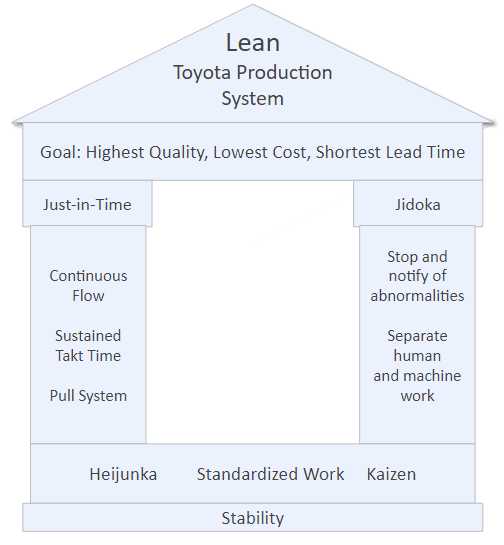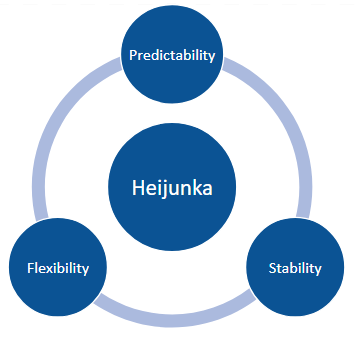What is Heijunka?

Heijunka (pronounced hey-june-kuh) is a Japanese word that means leveling. In Lean, it refers to the leveling of production, aimed at improving the flow of a process to better match customer demand, reduce waste, and decrease or quit batch processing.
It forms the foundation of Lean, or the Toyota Production System, along with the concept of standardized work, and Kaizen. In the application of the Heijunka technique, customer demand is met through smaller batches, standardized work, and/or single-minute exchange of die (SMED).

Why does the leveling of production matter?
The focus of Lean is the reduction of waste and improved value to the customer. Mura - one of the forms of waste (muda) - comes from the Japanese word for unevenness. For example, in software development, there is a phenomenon known as the death march. It’s where, after slow and relaxed project beginnings, most work is crammed into the end project stages, during which team members are just expected to do overtime. An almost planned flow unevenness like this is simply unsustainable for the team and unhealthy for the business.
No system can be stable with uneven levels of production, and the Heijunka technique deals with this.
There are several reasons for unevenness in production:
- Different activities take different amounts of time to perform
- Different products take different activities and times to complete
- Different people and different machines have different capacities, working and setup times
- People tend to deprioritize the tasks they do not like doing, which pushes some items off their anticipated completion date
- Customer orders don’t typically come in an ordered, logical fashion
- A temporary material shortage might force deviating from the production schedule.
Production leveling by volume and type
Production teams, and most teams in general, tend to think that there is nothing wrong with the way they are working and that customers will simply receive their orders when they are ready. But Lean seeks to reduce the lead time, improve quality and value to the customer at all times. Lean thinking takes from the Kanban method, meaning that items are not built to forecast for future demand, but are produced only when customers order them. This way, production teams will never be working on products that won’t sell.
Traditional manufacturing has long lead times due to waste in the process, but above all, due to long material delivery times with sometimes unpredictable delays. It makes it challenging to accurately anticipate product demand, required for material ordering, while still keeping low stock - tying up as little capital as possible. Machines also take time to produce items, and before they do, they need to be set up, so a considerable amount of time may pass before they’re ready to work. Therefore, production controllers tend to manufacture articles in batches, minimizing the need for machine retooling with each product change.
Volume production leveling deals with containing the number of items produced in each batch while leveling by type adds different sequences of what product is being done in every batch.
Example
A factory has three customers for three different product lines. In a typical week, customer A orders 15 squares, customer B orders 3 circles, and customer C orders 1 triangle.

The production schedule to meet these requests would look like this:

The 15 squares take 2 days to make since the team can make 8 squares a day. The circle product takes 1 day to make (so 3 days to meet the order of 3), meaning the production team needs to work over the weekend to complete the triangle order, which takes a full day to complete.
A Lean practitioner would be looking at both the way this team works, and at how the customers place their orders (demand leveling). Through a systematic 5S exercise resulting in a reduction of bottlenecks, the plant could start to produce a circle in half a day, and a triangle in just under a day. Speaking with the customers, he may find that customer A only requires 3 of product A every day, but orders in advance just to be safe. Customer B needs a circle every other day and Customer C uses a triangle every 4 days.
Through this structured production leveling, the team can now produce three squares, one circle, and ¼ of a triangle in one day. They do the same on days 2 and 3, and on the 4th day are done with the triangles and can satisfy both clients B and C demand. Customer A has their needs covered by work performed daily, and their ability to only order as needed has improved their cash flow.

As a result, both the production team and the company have improved: they can ship products to paying customers every day, meet their demand, and stave off any costly overtime.
In manufacturing scenarios, it’s been common to use a Heijunka Box - a tool built from table-like cells with room for Kanban cards representing various order types and their amount. The same can be shown on a virtual Kanban board with swimlanes - horizontal rows. A team could use columns for days of the week, and rows for different product types, and place the demanded number of cards in each cell.
Did you know?
Kanban Tool® supports swimlanes - rows - by default. Consider trying it out as an easy to use Heijunka Box solution, or for any process visualization. It can be customized to virtually any need!
How to achieve a Heijunka flow?
Heijunka is not an easy state to be achieved and it does need a company to persist on its Lean journey. A leveled production is often associated with a mature Lean implementation and it often comes about together with the following practices:
- Single minute exchange of die
- Small batch sizes
- Kanban production system aligned with customer demand and driven by the customer-facing team
- Knowing your customer
To achieve Heijunka, a company should do the following:
Step 1: Standardize work
Attempting to standardize work is a simple first step to know how and where to improve it. Through the process, teams will understand how to differentiate between internal and external work, learn to practice the assigned operating procedures, and handle errors correctly.
Step 2: Work on improving the takt time
A Lean company executes work according to the customer’s takt time and must understand when clients need their product. The production team should then use Kanban not only for the work required but also for the materials required according to the customer’s orders.
At Toyota, the production department is subject to the purchasing department controlling the materials issued, based on customer demand. The takt time is the customer’s buying rate, and matching this to your production will reduce waste. This kind of leveling is considered one of the highest achievements in Lean application.

Step 3: Sequencing
Work should be sequenced to ensure many small batches, as opposed to one large volume, and order delivery should be executed in the same sequence that it was placed in. At Toyota, the ordering of materials and production of goods is aligned with the principle of Just-in-time (JIT) - items are simply delivered to customers when they need it.
The process of standardizing work also includes optimization of the system’s ability to rapidly change tools and refocus (SMED), which makes efficient sequencing possible. For the company from our above example, their work organization only makes sense if production can switch between manufacturing circles, triangles, and squares without significant additional effort. That’s why minimizing set-up times is so important.
Establishing Heijunka in your process would give you a competitive advantage by:
- Having reduced WIP and an underutilized inventory, meaning a reduction in costs
- Being able to maintain the declared takt time: produce what and how your customers want, when they want it
- Having the ability to better inform suppliers as to when you require materials
- Making your staff’s work easier and less stressful.